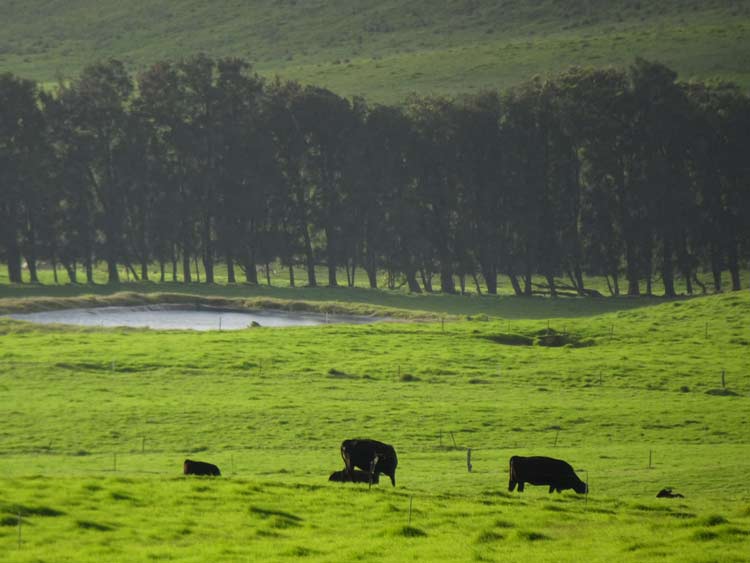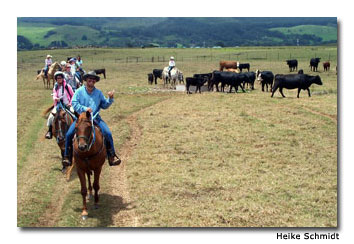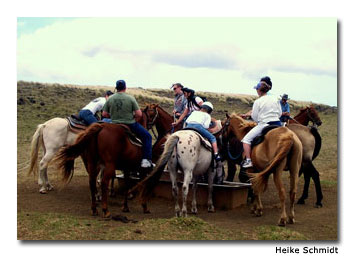

Sometimes, I wish I were a cow on Hawaii. Particularly in Waimea, here in the northern interior of the Big Island.
The Island of Hawaii
Big Island — this is what locals affectionately call their island. Since the island of Hawaii is the largest of the chain — you could fit the other seven major islands into it — the island’s official name “Hawaii” was also chosen as the name of the 50th U.S. state.
A fresh trade wind is always blowing up here in Waimea, at the foot of the picture-book volcano Mauna Kea, at 13,796 feet (4,208 m) the highest mountain in the islands. Puffy cotton clouds sail over a crisp blue sky.
Lush green grasses grow from the fertile lava earth. And the panorama? With steep real estate prices on the islands, most two-legged natives can hardly afford such a beautiful mountain location with commanding vistas of the cobalt blue Pacific. Ruminating with a view — Hawaii is a paradise even for cows, if it weren’t for those pesky cowboys.
Ranching in Hawaii
Who knew cowboys roamed this tropical island? After Queen Liliuokalani was overthrown by American and European Hawaiians who were threatened by the elimination of suffrage in the queen’s proposed constitution, the United States annexed Hawaii in 1898.
At the time, ranching was the economic backbone of much of the mainland United States.
Waimea is Hawaii’s ranching center. Around here, tanned beach boys in pretty flower-print surfing shorts are still an exception today. The cowboy tradition started around the year 1830 in these tropical highlands, many years ahead of the first lasso being uncoiled in the Wild West — a fact that many Waimeans like to point out, proudly and frequently.
The friendly people of this sleepy town prefer riding on horseback to riding a wave and, instead of flip flops, they wear cowboy boots.

Take Keoki Wood, for instance. His actual name is George, which he translated into Hawaiian. It really should be “John,” as he looks quite similar to John Wayne: blond and tall, with broad shoulders, water-blue eyes and a large hat with a wide brim.
Keoki is livestock operations manager for Parker Ranch. He is one of 12 paniolos who work for Hawaii’s largest cattle farm. Paniolo is the Hawaiian word for español, or Spanish, explains Keoki. This is what the first cowboys were called when they were invited by King Kamehameha to his island empire in 1832 from Mexico, to get a grip on marauding cattle herds.
George Vancouver had meant well when he brought five longhorns along on his second visit here. (Together with James Cook, Vancouver had discovered Hawaii for the western world in 1778.) If Vancouver had known about the longterm consequences of his well-intended gift, he would surely turn in his grave today.
King Kamehameha
King Kamehameha must have been pleased with the exotic present, as he ordered the animals not to be touched by anyone, so that their numbers would increase quickly. And multiply, they did.
It was not long until the horned bovines were munching away on the thatched roofs of terrified islanders. To come across a bad-tempered bull in the dark could be a deadly mistake. Soon Hawaii was looking for outside help to cope with a biological experiment gone awry. John Palmer Parker was the first marksman who was officially commissioned by his majesty to cull the unrestrained beasts.
Palmer, a ship’s clerk who jumped ship in Hawaii and decided to stay, settled permanently on Hawaii, where he was eventually hired to work with the king’s cattle. He kept some of the best breeding animals for part of his wages. He married a Hawaiian princess and started a ranching dynasty — a fairytale ascent.
Parker Ranch
Thanks to his blue-blooded wife Kipikane, the foreigner from Massachusetts was allowed to acquire parcels of land that grew, little by little, to become a gigantic estate. In its heyday, the ranch, founded in 1847, spread over 225,000 square miles (910 km²), making Parker’s empire the largest cattle farm owned by a private person in the entire United States.
Today Parker’s cattle kingdom has shrunk by roughly 20 percent, to about the size of 175,000 football fields — still big enough to tire out any cowboy horse. Keoki and his fellow workers each have six hoofed partners to take turns with, plus an all-terrain vehicle (ATV) to guard approximately 35,000 cattle and 250 mustangs.

The Parker Ranch Foundation Trust manages the ranching business, including two historical farm houses: Mana Hale, a modest cottage made from precious koa wood, was the first home of the Parker clan. The lemon-colored mansion Puuopelu, built in 1862, houses the impressive international art collection of Richard Smart (1913-1922), who was not only Parker Ranch’s last owner, but also a celebrated Broadway actor. Both homes are open to visitors.
Parker Ranch dominates the charming town of Waimea, population 7,000. To avoid confusion with its namesake on Kauai, the settlement’s official postal name is Kamuela, named after Parker’s grandson, Samuel, which translates to Kamuela in Hawaiian.
Parts of Waimea even belong to Parker Ranchland. Everywhere I look I see the Parker Ranch logo. A Parker Ranch rodeo is held twice a year in town. There is a Parker Ranch shopping center here, a Parker Ranch gift shop and a small historical museum, as well.
In the museum, I gaze in disbelief at old sepia-tone photographs on display of swimming cows tied to both sides of life rafts by their horns. In the next picture the animals are heaved with slings onto waiting steamships.
Parker Ranch produced one-third of the state’s beef in the past, and is still a major supplier today. It’s not too long ago that loading docks replaced the more adventurous method.
It comes as no surprise to me that the poor creatures took cover from being shipped away from pastures of paradise to slaughterhouses. Some maverick cattle always manage to escape and hide in Hawaii’s thickets.
“Our cattle are smart,” Keoki grins, with a twinkle in his eyes, “smarter than some cowboys.”
The one-hour wagon ride with Kohala Carriages starts in front of the historical museum. Two stomping Clydesdale horses pull a covered coach over rustic ranchland, past stone orrals and horse stables. Isaac Haworth is the driver, and he shares local cowboy lore with his passengers.
As I let my eyes wander over rolling hills of green, I almost feel like I’m on safari. Bulls have attacked lone cowboys working the hinterlands of the ranch, we are told. But today, no wild cows are in sight.
Perhaps my chances are better on horseback, and I sign up with Cowboys of Hawaii for a ride over the open range. I do get to see cattle now, but only of the domesticated kind. They are happily munching away, and seem to frown at us intruders trotting past them in single file. The sky is big. The land is wide. Prickly cacti grow in between tall prairie grasses.
I could nearly forget that I am not riding across Texas, but over a Polynesian dream island in the middle of the Pacific Ocean if it wasn’t for the paniolo taking the reins out of my hands as we arrive back at the stables.
He has a big smile on his face. As we say goodbye he lifts his cowboy hat, which is a colorful hibiscus flower print.
For special occasions he will even decorate it, he says, not with feathers, but Hawaiian-style, of course — with a fragrant flower garland.
- Travel Guide to Colorado - April 26, 2024
- Travel Guide to Croatia - April 26, 2024
- Top 10 Things to Do in Ireland - April 25, 2024
